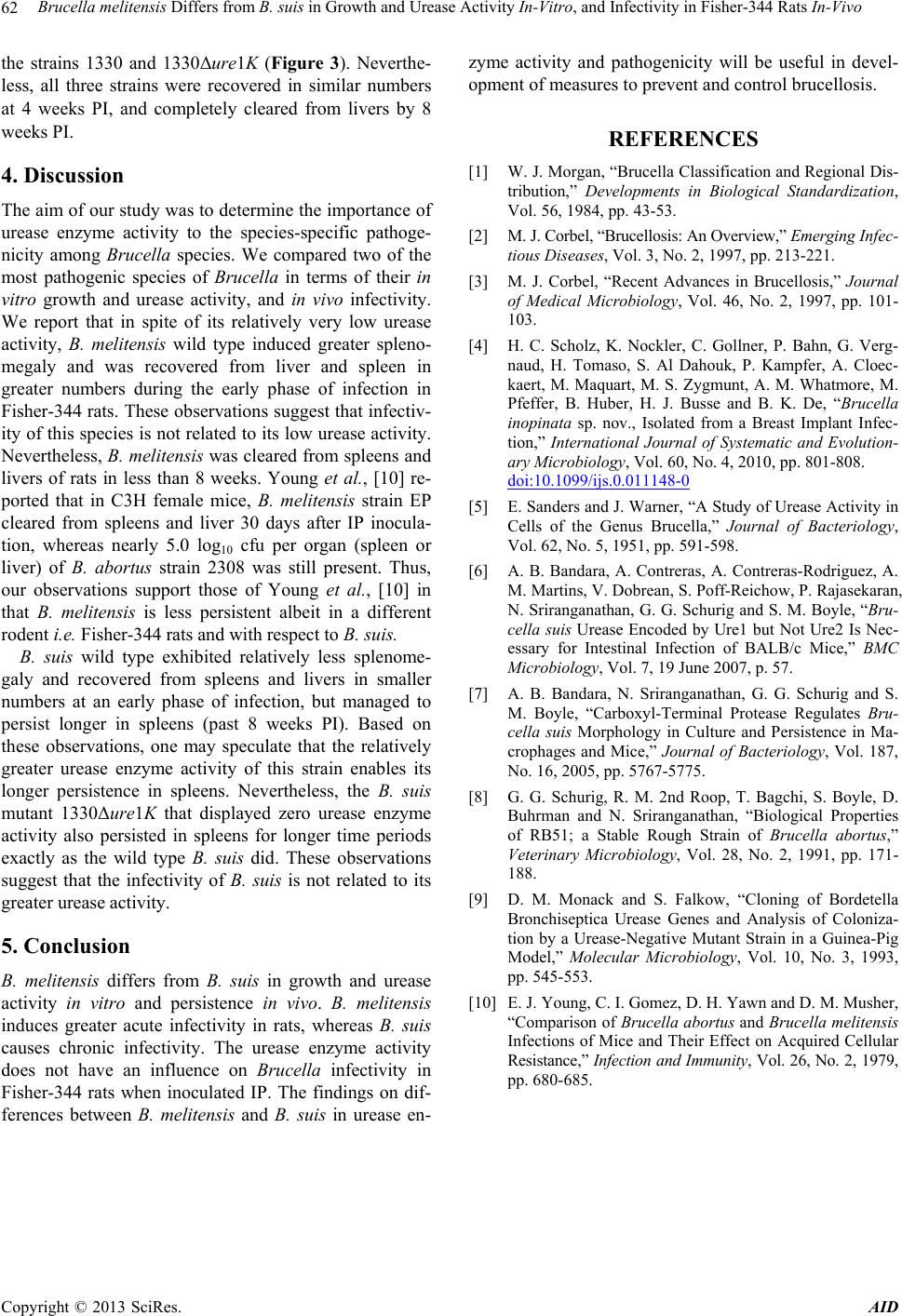
Brucella melitensis Differs from B. suis in Growth and Urease Activity In-Vitro, and Infectivity in Fisher-344 Rats In-Vivo
Copyright © 2013 SciRes. AID
62
the strains 1330 and 1330Δure1K (Figure 3). Neverthe-
less, all three strains were recovered in similar numbers
at 4 weeks PI, and completely cleared from livers by 8
weeks PI.
4. Discussion
The aim of our study was to determine the importance of
urease enzyme activity to the species-specific pathoge-
nicity among Brucella species. We compared two of the
most pathogenic species of Brucella in terms of their in
vitro growth and urease activity, and in vivo infectivity.
We report that in spite of its relatively very low urease
activity, B. melitensis wild type induced greater spleno-
megaly and was recovered from liver and spleen in
greater numbers during the early phase of infection in
Fisher-344 rats. These observations suggest that infectiv-
ity of this species is not related to its low urease activity.
Nevertheless, B. melitensis was cleared from spleens and
livers of rats in less than 8 weeks. Young et al., [10] re-
ported that in C3H female mice, B. melitensis strain EP
cleared from spleens and liver 30 days after IP inocula-
tion, whereas nearly 5.0 log10 cfu per organ (spleen or
liver) of B. abortus strain 2308 was still present. Thus,
our observations support those of Young et al., [10] in
that B. melitensis is less persistent albeit in a different
rodent i.e. Fisher-344 rats and with respect to B. suis.
B. suis wild type exhibited relatively less splenome-
galy and recovered from spleens and livers in smaller
numbers at an early phase of infection, but managed to
persist longer in spleens (past 8 weeks PI). Based on
these observations, one may speculate that the relatively
greater urease enzyme activity of this strain enables its
longer persistence in spleens. Nevertheless, the B. suis
mutant 1330Δure1K that displayed zero urease enzyme
activity also persisted in spleens for longer time periods
exactly as the wild type B. suis did. These observations
suggest that the infectivity of B. suis is not related to its
greater urease activity.
5. Conclusion
B. melitensis differs from B. suis in growth and urease
activity in vitro and persistence in vivo. B. melitensis
induces greater acute infectivity in rats, whereas B. suis
causes chronic infectivity. The urease enzyme activity
does not have an influence on Brucella infectivity in
Fisher-344 rats when inoculated IP. The findings on dif-
ferences between B. melitensis and B. suis in urease en-
zyme activity and pathogenicity will be useful in devel-
opment of measures to prevent and control brucellosis.
REFERENCES
[1] W. J. Morgan, “Brucella Classification and Regional Dis-
tribution,” Developments in Biological Standardization,
Vol. 56, 1984, pp. 43-53.
[2] M. J. Corbel, “Brucellosis: An Overview,” Emerging Infec-
tious Diseases, Vol. 3, No. 2, 1997, pp. 213-221.
[3] M. J. Corbel, “Recent Advances in Brucellosis,” Journal
of Medical Microbiology, Vol. 46, No. 2, 1997, pp. 101-
103.
[4] H. C. Scholz, K. Nockler, C. Gollner, P. Bahn, G. Verg-
naud, H. Tomaso, S. Al Dahouk, P. Kampfer, A. Cloec-
kaert, M. Maquart, M. S. Zygmunt, A. M. Whatmore, M.
Pfeffer, B. Huber, H. J. Busse and B. K. De, “Brucella
inopinata sp. nov., Isolated from a Breast Implant Infec-
tion,” International Journal of Systematic and Evolution-
ary Microbiology, Vol. 60, No. 4, 2010, pp. 801-808.
doi:10.1099/ijs.0.011148-0
[5] E. Sanders and J. Warner, “A Study of Urease Activity in
Cells of the Genus Brucella,” Journal of Bacteriology,
Vol. 62, No. 5, 1951, pp. 591-598.
[6] A. B. Bandara, A. Contreras, A. Contreras-Rodriguez, A.
M. Martins, V. Dobrean, S. Poff-Reichow, P. Rajasekaran,
N. Sriranganathan, G. G. Schurig and S. M. Boyle, “Bru-
cella suis Urease Encoded by Ure1 but Not Ure2 Is Nec-
essary for Intestinal Infection of BALB/c Mice,” BMC
Microbiology, Vol. 7, 19 June 2007, p. 57.
[7] A. B. Bandara, N. Sriranganathan, G. G. Schurig and S.
M. Boyle, “Carboxyl-Terminal Protease Regulates Bru-
cella suis Morphology in Culture and Persistence in Ma-
crophages and Mice,” Journal of Bacteriology, Vol. 187,
No. 16, 2005, pp. 5767-5775.
[8] G. G. Schurig, R. M. 2nd Roop, T. Bagchi, S. Boyle, D.
Buhrman and N. Sriranganathan, “Biological Properties
of RB51; a Stable Rough Strain of Brucella abortus,”
Veterinary Microbiology, Vol. 28, No. 2, 1991, pp. 171-
188.
[9] D. M. Monack and S. Falkow, “Cloning of Bordetella
Bronchiseptica Urease Genes and Analysis of Coloniza-
tion by a Urease-Negative Mutant Strain in a Guinea-Pig
Model,” Molecular Microbiology, Vol. 10, No. 3, 1993,
pp. 545-553.
[10] E. J. Young, C. I. Gomez, D. H. Yawn and D. M. Musher,
“Comparison of Brucella abortus and Brucella melitensis
Infections of Mice and Their Effect on Acquired Cellular
Resistance,” Infection an d Immunity, Vol. 26, No. 2, 1979,
pp. 680-685.